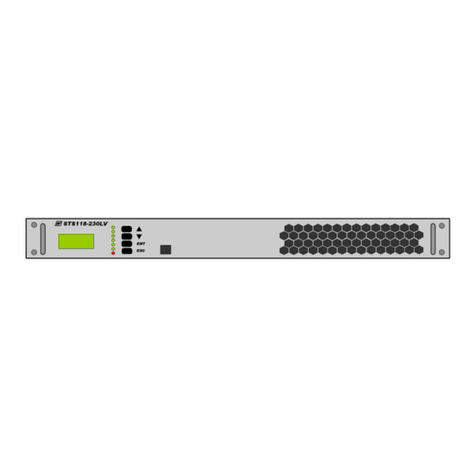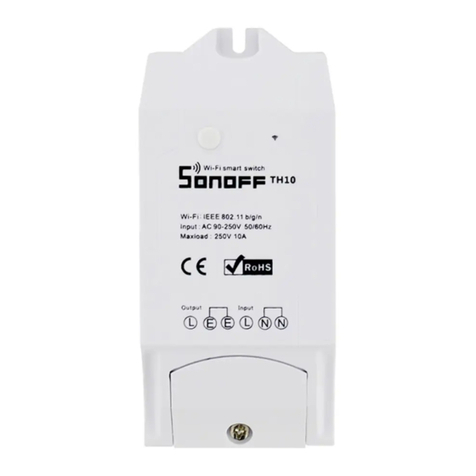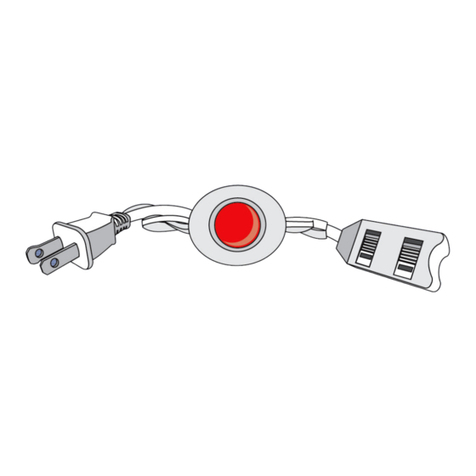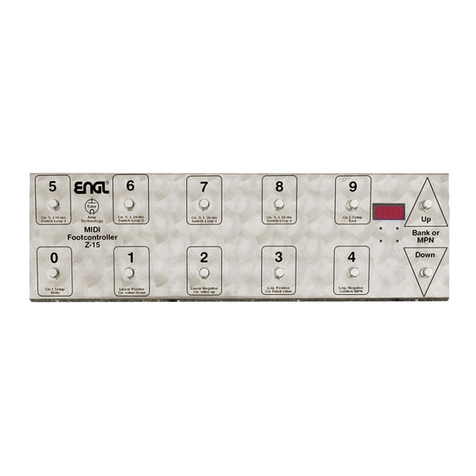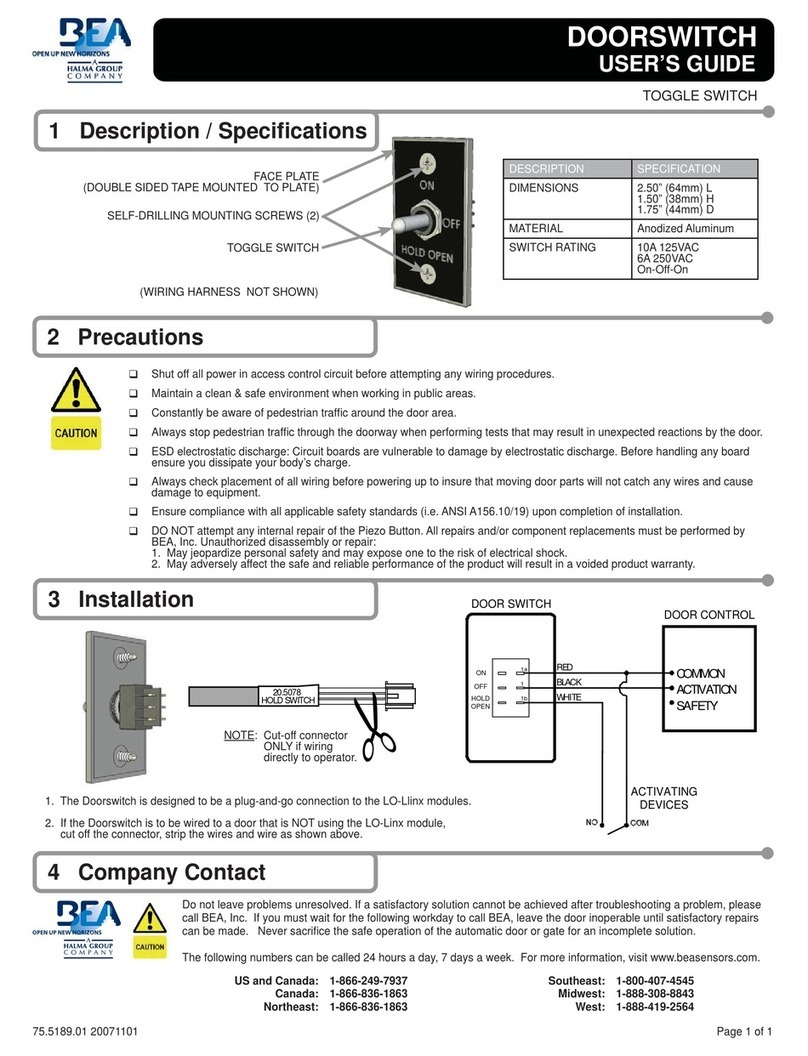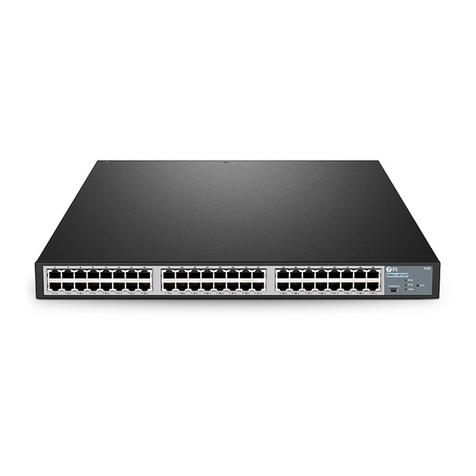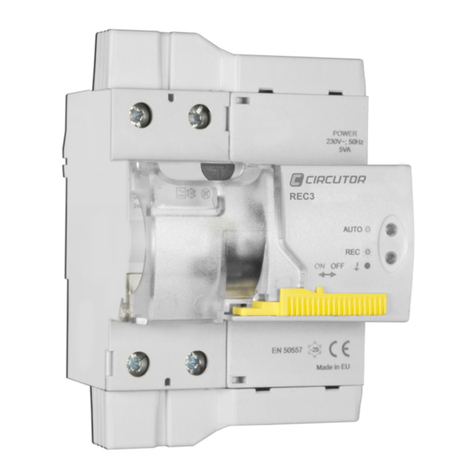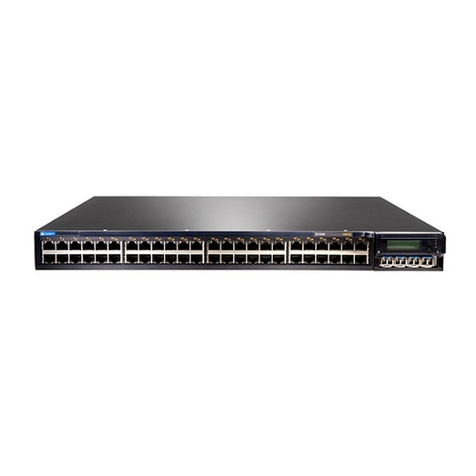Eltek Valere STS207 User manual

STATIC TRANSFER SWITCH
STS207
USER MANUAL
UM_STS207_WEB_E_R1.4

Static Transfer Switch
STS207
User Manual
Page 2 (28)
ELTEK VALERE DEUTSCHLAND ©2009 UM_STS207_WEB_E_R1.4
Notes on this manual
ATTENTION! Read this manual carefully before installing and commissioning the specified module. This
manual is a part of the delivered module. Familiarity with the contents of this manual is required for
installing and operating the specified module.
The function description in this manual corresponds to the stage of technology at the date of publish-
ing. Technical changes and changes in form and content can be made at any time by the manufacturer
without notice. There are no obligations to update the manual continually. The rules for prevention of
accidents for the specific country and the general safety rules in
accordance with IEC 364 must be observed.
The module is manufactured in accordance with applicable DIN and VDE standards such as VDE 0106
(part 100) and VDE 0100 (part 410). The CE marking on the module confirms compliance with EU stan-
dards 2006-95-EG (low voltage) and 2004-108-EG (electromagnetic compatibility) if the installation and
operation instructions are followed.
Supplier:
ELTEK VALERE DEUTSCHLAND GmbH
GB Industrial
Schillerstraße 16
D-32052 Herford
+ 49 (0) 5221 1708-210
FAX + 49 (0) 5221 1708-222
Internet http://www.eltekvalere.com
Changes and errors excepted.
2009. ELTEK VALERE DEUTSCHLAND GmbH. All rights reserved.
Please note: No part of this document may be reproduced or transmitted in any form or by any means
-electronic or mechanical, including photocopying and recording- for whatever reason without the ex-
plicit written permission of Eltek Valere.

Static Transfer Switch
STS207
User Manual
Page 3 (28)
ELTEK VALERE DEUTSCHLAND ©2009 UM_STS207_WEB_E_R1.4
The current revision status of this manual is the following:
Revision: 1.4
Date: 2010-05-17
Revision Description of change Writer Date
00 Preliminary first edition RTH 2007-10-25
01 First edition RTH 2008-05-07
02
Minor text modifications, screenshot
“Net Connection” updated, section “Trouble Shooting” com-
pleted
RTH 2008-07-18
1.3 Minor text modifications, new revision numbering (X.X) intro-
duced RTH 2008-10-28
1.4 Minor text modifications at section 2.2 "Operating modes". RTH 2010-05-17

Static Transfer Switch
STS207
User Manual
Page 4 (28)
ELTEK VALERE DEUTSCHLAND ©2009 UM_STS207_WEB_E_R1.4
Table of Contents
1A. Safety Instructions.....................................................................................................................6
1B. Electric Waste Disposal .............................................................................................................6
2. General Information ......................................................................................................................7
2.1 Example of use .........................................................................................................................................................7
2.2 Operating modes......................................................................................................................................................8
2.2.1 "Inverter priority" (default setting) ..............................................................................................................8
2.2.2 "Mains priority"..................................................................................................................................................8
3. Type Range/ Main Data................................................................................................................8
3.1 Main output data......................................................................................................................................................8
3.2 Optional equipment for STS assembly: ..............................................................................................................9
3.3 Front view: operating elements, indicators.................................................................................................... 10
3.4 Electrical connections.......................................................................................................................................... 11
3.4.1 Pin assignment of the rear side connector: ........................................................................................... 11
3.4.2 Pin assignment of the front side CAN-Bus connector (RJ11): ........................................................... 12
3.4.3 Pin assignment of the front side Ethernet connector (RJ45):........................................................... 12
3.5 Cooling/Air flow direction ................................................................................................................................... 13
3.6 Communication interfaces ................................................................................................................................. 13
3.6.1 CAN-Bus........................................................................................................................................................... 13
3.6.2 Ethernet (Net Connection).......................................................................................................................... 14
4. Handling ........................................................................................................................................ 15
4.1 Storage .................................................................................................................................................................... 15
4.2 Commissioning....................................................................................................................................................... 15
4.3 Operation................................................................................................................................................................. 15
4.3.1 LED Indications............................................................................................................................................... 16
4.3.2 Adjustment keys........................................................................................................................................... 16
4.3.3 LC-Display: Indication of measured values and alarm messages ..................................................... 17
5. Parameter adjustment / Menu structure............................................................................. 18
5.1 Adjustable Parameters (Customer menu) ...................................................................................................... 18
5.2 Structure of the customer menu...................................................................................................................... 19
6. Maintenance ................................................................................................................................ 21
7. Trouble shooting......................................................................................................................... 21
8. Technical specifications ........................................................................................................... 23
8.1 Dimensional drawings .......................................................................................................................................... 25
9. Your notes .................................................................................................................................... 26

Static Transfer Switch
STS207
User Manual
Page 5 (28)
ELTEK VALERE DEUTSCHLAND ©2009 UM_STS207_WEB_E_R1.4
Index of Figures
Figure 1. Block diagram “Example of use” ....................................................................................................................7
Figure 2. AC Rack ACR INV222-6.75 ..............................................................................................................................9
Figure 3. Front view......................................................................................................................................................... 10
Figure 4. Rear side connector....................................................................................................................................... 11
Figure 5. Front side CAN-Bus connector.................................................................................................................... 12
Figure 6. Front side Ethernet connector.................................................................................................................... 12
Figure 7. Module air flow ................................................................................................................................................ 13
Figure 8. Sample screenshot ........................................................................................................................................ 14
Figure 9. LC-Display: Indication of measured values .............................................................................................. 17
Figure 10. Structure of the customer menu............................................................................................................. 19
Figure 11. Continuation of the customer menu....................................................................................................... 20
Figure 12. Display “Alarm Messages”.......................................................................................................................... 21
Figure 13. Module dimensions...................................................................................................................................... 25

Static Transfer Switch
STS207
User Manual
Page 6 (28)
ELTEK VALERE DEUTSCHLAND ©2009 UM_STS207_WEB_E_R1.4
1A. Safety Instructions
Warning!
Because several components of operating electrical modules are charged by dangerous voltage, the
improper handling of electrical modules may be the cause of accidents involving electrocution, injury, or
material damages.
Operation and maintenance of electrical modules must be performed by qualified skilled per-
sonnel such as electricians in accordance with EN 50110-1 or IEC 60950.
Install the module only in areas with limited access to unskilled personnel.
Before starting work, the electrical module must be disconnected from mains. Make sure that
the module is earthed.
Do not touch connector pins as they can be charged with dangerous voltage up to 30 seconds
after disconnection.
Only spare parts approved by the manufacturer must be used.
1B. Electric Waste Disposal
Separate collection is the precondition to ensure specific treatment and recycling of waste electrical
and electronic equipment and is necessary to achieve the chosen level of protection of human health
and the environment.
In the case of waste disposal of your discarded equipment we recommend to contact a waste man-
agement company.

Static Transfer Switch
STS207
User Manual
Page 7 (28)
ELTEK VALERE DEUTSCHLAND ©2009 UM_STS207_WEB_E_R1.4
2. General Information
The static transfer switch STS207 is designed for a nominal switching capacity of 7kVA and is used for
nearly interruption free switching (<4 ms) between two AC sources (usually inverter and substitute-
mains supply). It is intended for the operation in combination with inverters of series INV215/222. Con-
sequently AC consumer loads can be driven nearly without interruption if one of the two power sources
fails.
The STS207 is a hot plug-in module with rear side connectors and is designed to be mounted in an
assembly set sub rack (see section 3.2).
The operation and indication elements as well as an Ethernet and CAN-Bus connector are user-friendly
integrated in the front plate of the unit.
2.1 Example of use
Figure 1. Block diagram “Example of use”

Static Transfer Switch
STS207
User Manual
Page 8 (28)
ELTEK VALERE DEUTSCHLAND ©2009 UM_STS207_WEB_E_R1.4
2.2 Operating modes
The static transfer switch STS is designed for the operating modes “inverter priority” and
“mains priority” alternatively. The consumer load is energized by the priority source as long as that
source works faultlessly.
REMARK: The unit's default setting is "Inverter priority".
The priority source is programmable using "service menu 2" (only available on request for qualified and
skilled service personnel).
2.2.1 "Inverter priority" (default setting)
At the operating mode “inverter priority” the load is switched on inverters during normal operation.
Source “Mains” only is required to energize the consumer load if source “Inverter” fails or is overloaded
(i. e. distortions by short circuit behaviour or overload).
2.2.2 "Mains priority"
At the operating mode “mains priority” AC mains works as priority source and the inverter
(as “substitute mains”) as source 2. The STS only switches to inverter(s) when mains failes.
3. Type Range/ Main Data
Type Designation Article Code Nominal
Input
Nominal Input
Frequency
Redundant Circuitry
Supply
STS207-230/230HV 601-070-715.00 230VAC 50 Hz/ 60Hz
(ad
j
ustable)
91.8-275VDC (high
volta
g
e version)
STS207-230/230LV 601-070-515.00 230VAC 50 Hz/ 60Hz
(ad
j
ustable)
38-75VDC (low
volta
g
e version)
STS207-230/230-
24V
601-070-415.00 230VAC 50 Hz/ 60Hz
(ad
j
ustable)
19-45VDC (24V
version)
3.1 Main output data
Nominal output voltage: 230VAC
Nominal output current: 30.4AAC
Nominal switching capacity: 7kVA
Output frequency: according to the input frequency
For more specific data, see section 8.

Static Transfer Switch
STS207
User Manual
Page 9 (28)
ELTEK VALERE DEUTSCHLAND ©2009 UM_STS207_WEB_E_R1.4
3.2 Optional equipment for STS assembly:
AC Rack ACR INV222-6.75 LV (assembly set 19” sub rack 2U for max. three inverters INV215-24,
INV222-48 or INV222-60 and for one static transfer switch STS207-24V or STS207LV including
a wired backplane): Material code= 502-222-315.LV
AC Rack ACR INV222-6.75 HV (assembly set 19” sub rack 2U for max. three inverters INV222-
110 or INV222-220 and for one static transfer switch STS207HV including a wired backplane):
Material code= 502-222-315.HV
Figure 2. AC Rack ACR INV222-6.75 fully equipped
with three inverters INV222 and
one static transfer switch STS207

Static Transfer Switch
STS207
User Manual
Page 10 (28)
ELTEK VALERE DEUTSCHLAND ©2009 UM_STS207_WEB_E_R1.4
3.3 Front view: operating elements, indicators
Figure 3. Front view
For more information about the operating elements, LED indicators, LC-Display and front connectors,
see the following sections.
The STS207 is equipped with:
One LC-Display (4 x 16 characters)
Seven LED indicators: STANDBY, INVERTER, MAINS,
LOAD ON INVERTER, LOAD ON MAINS, SYNC, ALARM
(Collective failure)
Four adjustment keys: Up, Down, ENT, ESC
One captive screw is used for each module to
secure it to the sub rack (component of the module).
CAN connector (RJ11)
Ethernet connector 10/100MB (RJ45)

Static Transfer Switch
STS207
User Manual
Page 11 (28)
ELTEK VALERE DEUTSCHLAND ©2009 UM_STS207_WEB_E_R1.4
3.4 Electrical connections
The STS207 is equipped with:
1 rear side connector for: AC input 1 (inverter), AC input 2 (mains), AC output and signalling
1 front side connector RJ11 (additional CAN-Bus connector)
1 front side connector RJ45 (Ethernet 10/100MB)
3.4.1 Pin assignment of the rear side connector:
Pin Designation
2b AC-Input 1 (Inverter)/Phase L1
5b STS-Output / Phase L1
8b AC-Input 2 (Mains)/Phase L1
11b Common Neutral Conductor
16a CAN_L Signal ( low )
17a CAN_V+ DC-Supply +8…15V
18a -
19a Synchronization / SYNC - STAT 2
20a -
16b CAN_V- DC-Supply GND
17b CAN_H Signal ( high )
18b Synchronization / SYNC - STAT 1
19b Synchronization / SYNC - SIG 2
20b -
16c Alarm relay output, NO
17c Alarm relay output, COM
18c Synchronization / SYNC - GND
19c Synchronization / SYNC - SIG 1
20c -
28b +Vi (DC-Power Supply*)
31b -Vi (DC-Power Supply*)
* STS207HV: Vi = 91.8-275VDC
STS207LV: Vi = 38-75VDC
STS207LV: Vi = 19-45VDC
Figure 4. Rear side connector (shown from the rear side of the module)

Static Transfer Switch
STS207
User Manual
Page 12 (28)
ELTEK VALERE DEUTSCHLAND ©2009 UM_STS207_WEB_E_R1.4
3.4.2 Pin assignment of the front side CAN-Bus connector (RJ11):
Pin Signals CAN Designation
1 CAN_V+ DC-Supply +8...15V
2 CAN_V+ DC-Supply +8...15V
3 CAN_H Signal (high)
4 CAN_L Signal (low)
5 CAN_V- DC-Supply Ground
6 CAN_V- DC-Supply Ground
16
Figure 5. Front side CAN-Bus connector
(socket outlet RJ11, 6-pole)
3.4.3 Pin assignment of the front side Ethernet connector (RJ45):
Pin Name Designation
1 TX+ Tranceive Data +
2 TX- Tranceive Data -
3 RX+ Receive Data +
4 n/c Not used
5 n/c Not used
6 RX- Receive Data -
7 n/c Not used
8 n/c Not used
Figure 6. Front side Ethernet connector
(socket outlet RJ45, 8-pole)

Static Transfer Switch
STS207
User Manual
Page 13 (28)
ELTEK VALERE DEUTSCHLAND ©2009 UM_STS207_WEB_E_R1.4
3.5 Cooling/Air flow direction
The unit is cooled by an internal fan. The airflow is from the front to rear side. The fan is monitored and
speed controlled dependent on module temperature. To provide sufficient air flow, a minimum space
(see item “A” in figure 7) of 50 mm is required between the unit and the rear cabinet wall as well as an
unobstructed supply of air to the front of the module.
Figure 7. Module air flow
3.6 Communication interfaces
3.6.1 CAN-Bus
The STS207 is equipped with a serial data interface in accordance with the Controller Area Network
(CAN) specification. The CAN-Bus connection is integrated in the rear side connector and an additional
one is located at the front panel.
The communication of the STS207 with the connected inverters and a possibly implemented UPC3 DC
controller unit takes place via CAN-Bus.
The following information is available via CAN:
Status information of the STS207:
Availability of the connected inverters
Availability of the substitute mains
Load on mains/inverter
Synchronization
Vbatt </>
Vout </>
Iout >
Output current of the STS
Battery voltage connected to the STS
Inverter and mains voltage
Inverter and mains frequency
STS module temperature

Static Transfer Switch
STS207
User Manual
Page 14 (28)
ELTEK VALERE DEUTSCHLAND ©2009 UM_STS207_WEB_E_R1.4
3.6.2 Ethernet (Net Connection)
Furthermore the STS207 is fitted with a front side Ethernet interface (10/100MB) for remote control
via HTTP (WEB server), SNMP, SMTP und SNTP.
The STS can be directly configured via PC. Furthermore, extensive remote control can be realized.
Figure 8. Sample screenshot “Net Connection”
REMARK: A manual for the Net Connection is separately available.

Static Transfer Switch
STS207
User Manual
Page 15 (28)
ELTEK VALERE DEUTSCHLAND ©2009 UM_STS207_WEB_E_R1.4
4. Handling
4.1 Storage
The STS must be stored in a dry, dust free environment with a storage temperature according to
specific data (see section 8).
4.2 Commissioning
Note: Before commissioning the module, make sure that the battery voltage for redundant circuitry
supply of the STS corresponds to the specification as specified on the type plate.
1. Carefully unpack the unit
2. Put the unit into the provided slot to the right of the sub rack.
3. Carefully slide in the unit until the module connector touched the backplane connector.
4. Increase the force until the unit fits in completely. Avoid using too much force. If the unit does not
fit in, begin again at step 2.
5. Secure the module using the captive screw provided with the module.
Caution: After switching off the module the internal capacitors are still fully charged. Do not touch
connector pins as they can still be charged with dangerous voltage after disconnection.
4.3 Operation
The operation of the unit takes place with keys located on the front side of the unit.
All main functional parameters and measured values are displayed on the front side LCD panel (text
indicator) as well as with LED indicators. The different functions are described in the following sections.

Static Transfer Switch
STS207
User Manual
Page 16 (28)
ELTEK VALERE DEUTSCHLAND ©2009 UM_STS207_WEB_E_R1.4
4.3.1 LED Indications
Functions of front panel LED indicators
LED Colour Main function Auxiliary function
green Unit is ready for operation
Inverter green Voltage and frequency of source
Inverter within permissible limit
Flashing when inverter overload
is detected
Mains green Voltage and frequency of source
Mains within permissible limit
Flashing when “Load on mains” is
activated (see menu 2)
Load on Inv. green Load feeding by source Inverter
Load on Mains green Load feeding by source Mains
Sync. green Inverters are synchronized to
mains phase and frequency
red
Collective Failure (the allocation
of the individual trouble codes is
programmable)
4.3.2 Adjustment keys
The adjustment takes place with four front keys:
Front keys Function
during menu item selection: change to
previous item (parameter)
during adjustment mode: increase value
during menu item selection: change to next item (parameter)
during adjustment mode: decrease value
ENT
enter menu (long pressed)
enter submenu
save parameter and leave submenu
ESC
leave the menu without changing
enter error list

Static Transfer Switch
STS207
User Manual
Page 17 (28)
ELTEK VALERE DEUTSCHLAND ©2009 UM_STS207_WEB_E_R1.4
4.3.3 LC-Display: Indication of measured values and alarm messages
In its initial state, the display shows the measured voltage of the input sources (AC output voltage of
inverter, mains voltage) and the STS output current.
Pushing the keys and changes between different display topics.
Figure 9. LC-Display: Indication of measured values
The display [1] shows the initial state (basic display). The plain text of the basic display becomes visible
after a successful start-up procedure. As shown in figure 9., you can select the displays [1], [2], [3] and
[4] by pressing the keys or :
If no inverter is registered, display [4] is not available.
If exactly one inverter is registered, display [4] is visible without inverter number.
If more than one inverter is registered, it is possible to call the parameters (input current,
output current and status) of all connected inverters in succession by pressing “ENT”.
The inverter number is shown in the first line of the display. Press “ESC” to go one step back.
The display automatically will revert to display [1] if no key is pressed for a period of more than
30 seconds.
Display [5] “Alarm messages” indicates the current alarm status. It can be selected from display [1], [2]
and [3] by pressing “ESC”.
By pressing the keys or you can scroll through the list of alarm messages if more than three
entries are present there. The display “Alarm messages” can be quit by pressing “ESC” again.
Basically (factory setting) all individual failures according to “List of the selectable individual alarm
messages“, (see section 5.1) are switched “active” and therefore they are visible on the display in case
of failure. The alarm messages which shall not be visible on the display in case of failure are to be
switched “inactive” in the customer menu (see the diagram “customer menu”).

Static Transfer Switch
STS207
User Manual
Page 18 (28)
ELTEK VALERE DEUTSCHLAND ©2009 UM_STS207_WEB_E_R1.4
5. Parameter adjustment / Menu structure
In the following sections, the adjustable parameters in the customer menu (available for each
customer) are described.
REMARK: The configuration of the system during commissioning takes place using service menu 1 and
2 and the network menu. They are code protected to guard against illegal parameter changes.
The special documents only are available for qualified and skilled service personnel.
5.1 Adjustable Parameters (Customer menu)
The following parameters can be adjusted according to the table below:
Customer menu Functions Range Default value
INV-count Number of connected inverters 0- 16 0
INV-redundancy Number of redundant inverters 0-15 0
Time/date Set new time and date --- ---
Configuration CF
Selection (set active/inactive) of single alarm
messages for the collective failure (CF)
signalization (LED and relay)
All alarm
messages*All active
Delay LED CF LED time delay of the collective failure signal 1- 60 sec 30
Delay Relay CF Time delay of the collective failure relay output 1- 60 sec 30
LCD-contrast Contrast adjustment of the display 0- 100 100
LCD backlight Background illumination Not used On
Language Selection of the language
english, german,
polish, swedish,
italian
english
*The following table shows a list of the selectable individual alarm messages:
Alarm messages Meaning
Source Mains f. Mains voltage or frequency not Ok
Source INV fail INV voltage or frequency not Ok
Synchr. error Mains and INV voltage are not
h
Inverter fail. INV failure
INV redundancy INV failure
INV count crit. INV failure
STS overtemp STS over temperature
STS overload STS output current to high
INV overload Actual output current exceeds the combined INV power
INV red. overl. Actual output current exceeds the combined and not redundant INV power
DC-voltage low Battery voltage low
DC-voltage high Battery voltage high
fan error Internal fan error
Uout error Output voltage < 95% Vin (Mains/INV)
Ubatt< warning Battery voltage < warning level
Ubatt> warning Battery voltage > warning level

Static Transfer Switch
STS207
User Manual
Page 19 (28)
ELTEK VALERE DEUTSCHLAND ©2009 UM_STS207_WEB_E_R1.4
5.2 Structure of the customer menu
The customer menu can be entered from the Basic display by pressing “ENT” for approx. three seconds
and then press “ENT” again.
For a list of all
selectable individual
alarm messages for
the collective failure
(CF) signalization, see
section 5.1
Figure 10. Structure of
the customer menu

Static Transfer Switch
STS207
User Manual
Page 20 (28)
ELTEK VALERE DEUTSCHLAND ©2009 UM_STS207_WEB_E_R1.4
Figure 11. Continuation of the customer menu
The final display shows the currently used Firmware version.
Table of contents
Other Eltek Valere Switch manuals
Popular Switch manuals by other brands

Arista
Arista 750 Series quick start guide
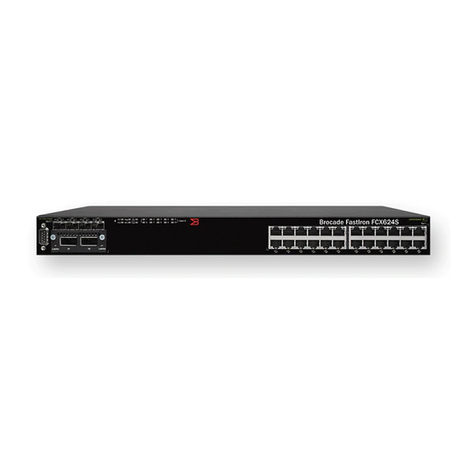
Brocade Communications Systems
Brocade Communications Systems FastIron CX installation guide

Lenovo
Lenovo ThinkSystem NE1032 installation guide
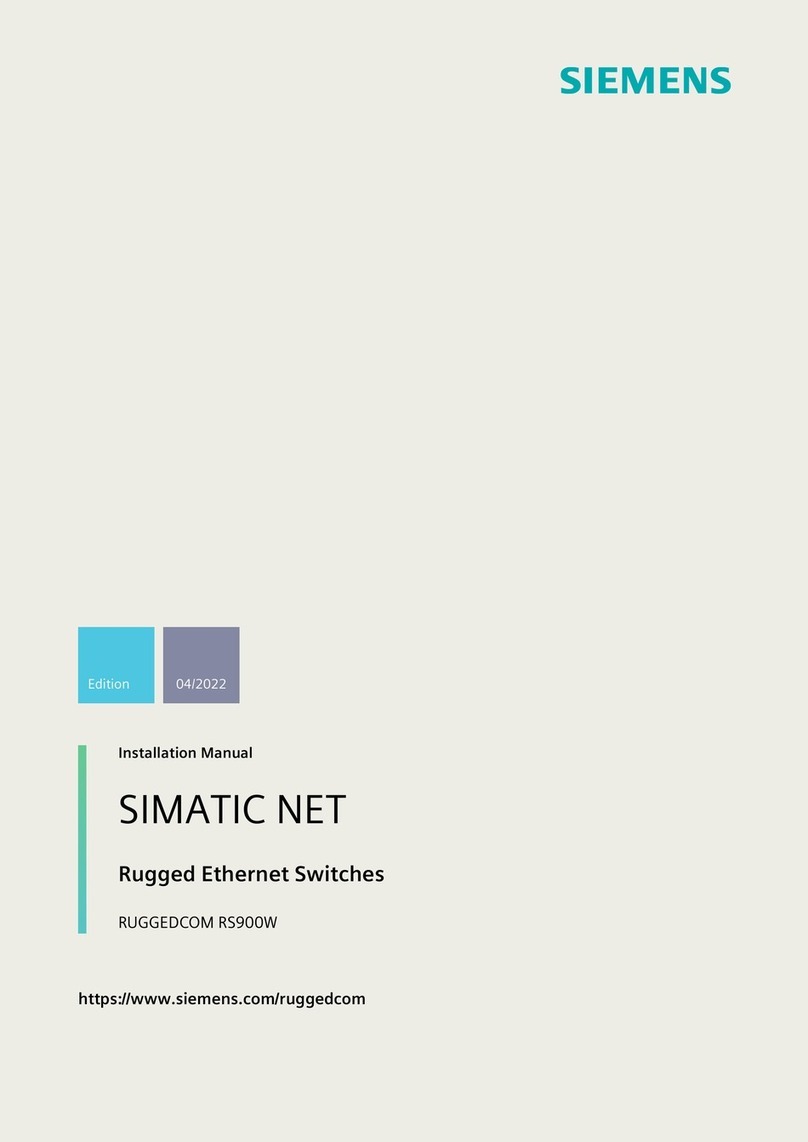
Siemens
Siemens SIMATIC NET RUGGEDCOM RS900W installation manual
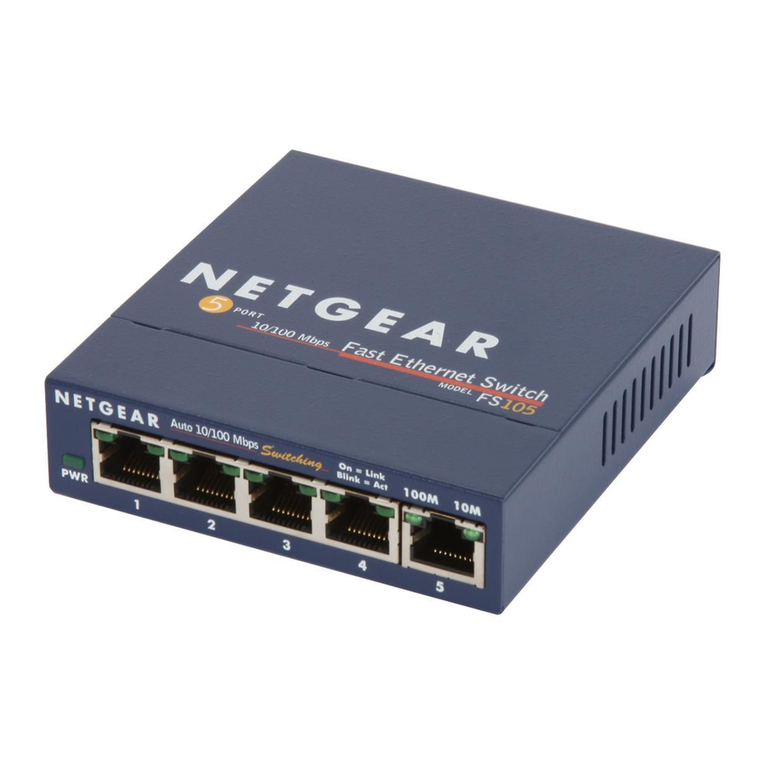
NETGEAR
NETGEAR ProSafe FS105v2 installation guide

Intellinet
Intellinet 523578 Specification sheet
